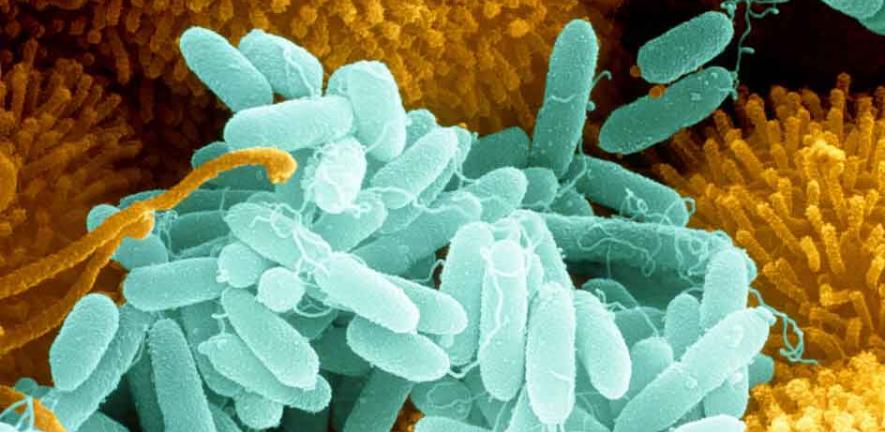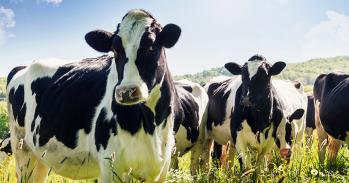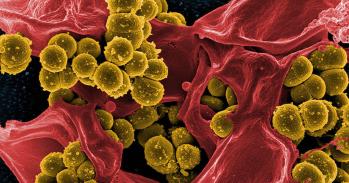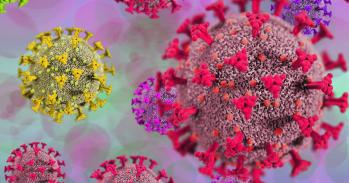
Targeting the ‘conversations’ that bacteria have with one another could herald a new generation of therapeutics that curb the virulence of infectious microbes.
Targeting the ‘conversations’ that bacteria have with one another could herald a new generation of therapeutics that curb the virulence of infectious microbes.
It's really timely to be thinking about how we can supplement the limited number of antibiotics in the pharmaceutical arsenal with new strategies.
Martin Welch
Bacteria don’t work alone. Like a well-organised gang, they wait until they are strong in number before unleashing their virulent weapons. They sense when their community has reached ‘quorum’ – the minimum number that must be present to transact their business – and they do so by ‘talking’ to each other. It is this remarkable communicative aspect of bacterial behaviour that researchers are now targeting as a way of combating infection.
Communication helps single-celled bacteria band together as a multicellular community to attack, or to defend themselves, or to respond to a change in their environment. “It’s a cute trick,” said Cambridge biochemist Professor George Salmond who, almost 25 years ago, was one of the first researchers to demonstrate how bacteria ‘team build’. “For virulence, for instance, it’s far better to attack the host with tissue-degrading toxins at the same time. It has maximum effect and overwhelms any immune defence system, compared with a piecemeal attack from individual cells.”
Bacteria communicate through the release of chemical signals that are picked up by their neighbours. It’s the concentration of these molecules that tells them when the gang is large enough to make it worthwhile to trigger a response. Once the concentration of the signal molecule reaches a certain threshold, it triggers population-wide changes in bacterial gene expression that kick-start cooperative behaviour.
Team building
Today, scientists know that there are many of these chemical signals – so-called quorum sensing (QS) molecules – and that they can help the bacteria carry out certain behaviours that are simply better to do as a group.
“In business terms, group effectiveness is often measured in terms of forming, storming, norming and performing, and this is effectively what bacteria do,” said Salmond. “They are almost independent at low density, but when they get to the right density they use the chemical signal to tell them to do something interesting and achieve their goal.”
Their goal might require them to perform more than one behaviour. Salmond’s work on the plant pathogen Erwinia – a problem in the potato industry – has shown that not only is the release of virulence factors coordinated to occur when the bacteria reach quorum but also the release of a bacterially made antibiotic. The antibiotic kills off other, non-Erwinia, bacteria in the vicinity.
“The virulence factors break down the potato and release nutrients that Erwinia can feed on, causing potato rot. But other bacteria are also present. You can imagine that if you’ve done all the work you wouldn’t want hangers-on to partake of your windfall,” he explained. “One rationale for having antibiotic production as well as virulence factor production under QS control is that you kill off your competitors to avoid them exploiting the nutritional bonus.”
Even something as straightforward as floating to the surface in a pond can be coordinated by QS, as Salmond and Professor Ray Goldstein in the Department of Applied Mathematics and Theoretical Physics are discovering in research funded by the Biotechnology and Biological Sciences Research Council (BBSRC).
Bacteria living in a watery environment often have tail-like flagella that help them swim, swarm or glide. But such movement is an energetically costly process. Salmond and Goldstein have found that some bacteria, such as Serratia, have an ingenious way of propelling themselves out of a crowd of different bacteria that is competing for the same nutrients and oxygen. Using QS to coordinate their activity, the bacteria produce tiny intracellular gas vesicles that float them to the pond surface, enabling them to colonise new territory as a team. “That’s the notion of bacterial gang culture – you hang together – it’s the chemical language of survival,” added Salmond.
Hijacking communication
In recent years, given its central role in coordinating virulence, QS has emerged as a promising target for therapeutic strategies aimed at treating bacterial infections. The idea is to interfere with the signalling mechanism to minimise destructive tissue damage and to increase the chance that the body’s immune system will clear the infection.
Researchers in Cambridge are concentrating their efforts on the activity of one bacterium in particular – Pseudomonas aeruginosa – a somewhat notorious human pathogen feared in hospitals because of its multidrug resistance and it being a lifelong burden to patients with cystic fibrosis (CF). In CF patients, the bacterium colonises the lung, forming a difficult-to-eradicate colony, or ‘biofilm’, which is frequently resistant to antibiotics. Crucially, both the production of virulence factors and the formation of biofilms are under QS control.
“With the increasing incidence of multidrug resistance in pathogenic bacteria, it’s really timely to be thinking about how we can supplement the limited number of antibiotics in the pharmaceutical arsenal with new strategies,” explained biochemist Dr Martin Welch, who collaborates with Salmond. “The idea is to develop QS inhibitors that make the bacteria avirulent and less prone to form biofilms, resulting in less lung damage and greater sensitivity to conventional antibiotics.”
Welch and Dr David Spring in the Department of Chemistry are developing approaches that disrupt QS in P. aeruginosa. Spring’s team of organic chemists are experts in the development and screening of small molecules that interfere with the QS process. “We have made antagonists to homoserine lactone QS molecules that block the action of the real signalling molecules, and some of these look as if they might be lead compounds for drug discovery,” said Spring.
With funding from the BBSRC, the researchers have more recently focused on a particular QS molecule named PQS, and are leading the field in the development of a ‘chemical toolbox’ for the study and modulation of this signalling mechanism.
The team is also investigating agonists – small molecules that upregulate QS – as Spring explained: “If we can activate QS at a lower density of bacteria then this could stimulate the immune system to attack when it has a chance of clearing the infection, before it is overwhelmed by a large-scale bacterial attack. What’s especially attractive about disrupting QS is that the system is not essential for bacterial survival so it’s less likely that resistance will develop quickly to a treatment targeting this process.”
However, they are quick to point out that medical applications may be many years in the future. “There is a catch for CF – it seems that the longer the bacteria live in the CF lung the more likely it is to drop QS, and perhaps antagonists may only be relevant at early stages,” said Welch. “Which is why we need to understand QS fully – when the process happens and when it doesn’t.”
Welch’s current research has focused on developing a ‘metagenomics’ approach that will enable researchers to sequence all of the many bacteria, not just P. aeruginosa, that reside in the CF lung. “It’s a zoo in there. All of these bacteria are probably chemically communicating to form an ecological network. We are particularly interested in understanding what impact antibiotics have on the global population structure; this may allow us to streamline future therapeutic interventions.”
What seems increasingly clear is that bacteria are far more sophisticated than single cells living in splendid isolation, as Salmond concluded: “You have to admire them. You develop a great respect for bacteria when you learn how they communicate together. They colonise every niche of the planet, were here long before we appeared and, no doubt, will be here long after we’re gone!”
For more information, please contact Louise Walsh at the University of Cambridge Office of External Affairs and Communications.
This work is licensed under a Creative Commons Licence. If you use this content on your site please link back to this page.





